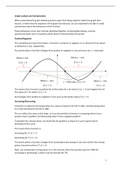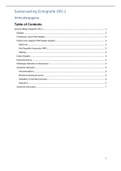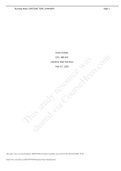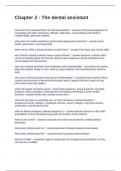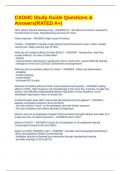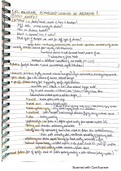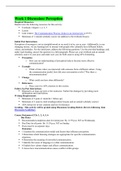Management
Accounting
,Inhoud
Management accounting supports decision making..................................................................................... 4
Variable and fixed costs................................................................................................................................ 4
Variable cost............................................................................................................................................. 4
Fixed cost.................................................................................................................................................. 4
Cost-volume-profit (CVP) Analysis................................................................................................................ 4
Variations of CVP equation........................................................................................................................... 6
CVP analysis for multiple products................................................................................................................ 6
CVP assumptions.......................................................................................................................................... 6
Other useful cost definitions......................................................................................................................... 6
Mixed cost:............................................................................................................................................... 6
Step variable cost...................................................................................................................................... 6
Incremental cost....................................................................................................................................... 6
Sunk cost.................................................................................................................................................. 7
Relevant cost............................................................................................................................................ 7
Opportunity cost....................................................................................................................................... 7
Avoidable cost.......................................................................................................................................... 7
Return on investment (ROI)...................................................................................................................... 7
Return on equity (ROE)................................................................................................................................. 7
Activity based cost systems........................................................................................................................... 8
Original activity based costing (ABC)............................................................................................................. 8
Two-stage estimation approach.................................................................................................................... 9
First stage................................................................................................................................................. 9
Second stage............................................................................................................................................. 9
Original activity based costing:..................................................................................................................... 9
Limitations of original ABC............................................................................................................................ 9
Time driven activity based costing (TDABC / time driven ABC)...................................................................10
Time driven ABC – first parameter.......................................................................................................... 10
Time driven ABC – second parameter..................................................................................................... 10
Measuring the cost of unused resource capacity........................................................................................ 10
Cost of unused capacity.............................................................................................................................. 11
Time driven ABC profitability report........................................................................................................... 11
Activity-based pricing.................................................................................................................................. 11
Budgeting:................................................................................................................................................... 11
,The role of budgets and budgeting............................................................................................................. 12
Budget for direct cost................................................................................................................................. 14
Variances.................................................................................................................................................... 14
Variance analysis......................................................................................................................................... 14
First-level variances.................................................................................................................................... 16
Planning and flexible budget variances....................................................................................................... 16
Second and third-level variances................................................................................................................ 16
Price variance & quantity variances............................................................................................................ 16
Sales variance............................................................................................................................................. 17
Sales variance with multiple products......................................................................................................... 17
, Hoofdstuk 1
Management accounting supports decision
making
Cost information is pervasive throughout decision-making situations:
(informatie over kosten is alomtegenwoordig in besluitvormingssituaties)
- Pricing
- Product planning
- Budgeting
- Performance evaluation
- Contracting
Variable and fixed costs
Variable cost
o A cost that changes in direct proportion to changes in the activity level of some variable,
this variable is called the cost driver
(een kost die veranderd in directe verhouding tot veranderingen in het activiteitenniveau
van een variabele, deze variabele wordt de kostendrijver genoemd)
Berekening:
Variabel cost:
Variable cost per unit of the cost driver * cost driver units
Fixed cost
o A cost that doesn’t vary in the short run with a specific activity
(kosten die op korte termijn niet variëren met een specifieke activiteit)
o The defining characteristics of fixed costs is that it depends on the amount of a resource
that is acquired rather than amount used
(de bepalende kenmerken van vaste kosten zijn dat het afhangt van de hoeveelheid van
een hulpbron die wordt verworven in plaats van de hoeveelheid die wordt gebruikt)
o Fixed costs are often called capacity-related costs
(vaste kosten worden vaak capaciteitsgerelateerde kosten genoemd)
Cost-volume-profit (CVP) Analysis
- CVP uses variable and fixed costs to identify the profit generated at various levels of activity
(CVP gebruikt variabele en vaste kosten om de winst te identificeren die op verschillende
activiteitsniveaus wordt gegenereerd)
- Contribution margin is the difference between total revenue and total variable costs
(bijdragemarge is het verschil tussen de totale omzet en de totale variabele kosten)
- Contribution margin per unit is the contribution each unit makes to covering fixed costs and
providing a profit
(bijdragemarge per eenheid is de bijdrage die elke eenheid levert aan het dekken van vaste
kosten en het behalen van winst)
- Contribution margin ratio is the ratio of contribution margin per unit to selling price per unit
(bijdragemargeverhouding is de verhouding tussen de contributiemarge/bijdragemarge per
eenheid en de verkoopprijs per eenheid
Accounting
,Inhoud
Management accounting supports decision making..................................................................................... 4
Variable and fixed costs................................................................................................................................ 4
Variable cost............................................................................................................................................. 4
Fixed cost.................................................................................................................................................. 4
Cost-volume-profit (CVP) Analysis................................................................................................................ 4
Variations of CVP equation........................................................................................................................... 6
CVP analysis for multiple products................................................................................................................ 6
CVP assumptions.......................................................................................................................................... 6
Other useful cost definitions......................................................................................................................... 6
Mixed cost:............................................................................................................................................... 6
Step variable cost...................................................................................................................................... 6
Incremental cost....................................................................................................................................... 6
Sunk cost.................................................................................................................................................. 7
Relevant cost............................................................................................................................................ 7
Opportunity cost....................................................................................................................................... 7
Avoidable cost.......................................................................................................................................... 7
Return on investment (ROI)...................................................................................................................... 7
Return on equity (ROE)................................................................................................................................. 7
Activity based cost systems........................................................................................................................... 8
Original activity based costing (ABC)............................................................................................................. 8
Two-stage estimation approach.................................................................................................................... 9
First stage................................................................................................................................................. 9
Second stage............................................................................................................................................. 9
Original activity based costing:..................................................................................................................... 9
Limitations of original ABC............................................................................................................................ 9
Time driven activity based costing (TDABC / time driven ABC)...................................................................10
Time driven ABC – first parameter.......................................................................................................... 10
Time driven ABC – second parameter..................................................................................................... 10
Measuring the cost of unused resource capacity........................................................................................ 10
Cost of unused capacity.............................................................................................................................. 11
Time driven ABC profitability report........................................................................................................... 11
Activity-based pricing.................................................................................................................................. 11
Budgeting:................................................................................................................................................... 11
,The role of budgets and budgeting............................................................................................................. 12
Budget for direct cost................................................................................................................................. 14
Variances.................................................................................................................................................... 14
Variance analysis......................................................................................................................................... 14
First-level variances.................................................................................................................................... 16
Planning and flexible budget variances....................................................................................................... 16
Second and third-level variances................................................................................................................ 16
Price variance & quantity variances............................................................................................................ 16
Sales variance............................................................................................................................................. 17
Sales variance with multiple products......................................................................................................... 17
, Hoofdstuk 1
Management accounting supports decision
making
Cost information is pervasive throughout decision-making situations:
(informatie over kosten is alomtegenwoordig in besluitvormingssituaties)
- Pricing
- Product planning
- Budgeting
- Performance evaluation
- Contracting
Variable and fixed costs
Variable cost
o A cost that changes in direct proportion to changes in the activity level of some variable,
this variable is called the cost driver
(een kost die veranderd in directe verhouding tot veranderingen in het activiteitenniveau
van een variabele, deze variabele wordt de kostendrijver genoemd)
Berekening:
Variabel cost:
Variable cost per unit of the cost driver * cost driver units
Fixed cost
o A cost that doesn’t vary in the short run with a specific activity
(kosten die op korte termijn niet variëren met een specifieke activiteit)
o The defining characteristics of fixed costs is that it depends on the amount of a resource
that is acquired rather than amount used
(de bepalende kenmerken van vaste kosten zijn dat het afhangt van de hoeveelheid van
een hulpbron die wordt verworven in plaats van de hoeveelheid die wordt gebruikt)
o Fixed costs are often called capacity-related costs
(vaste kosten worden vaak capaciteitsgerelateerde kosten genoemd)
Cost-volume-profit (CVP) Analysis
- CVP uses variable and fixed costs to identify the profit generated at various levels of activity
(CVP gebruikt variabele en vaste kosten om de winst te identificeren die op verschillende
activiteitsniveaus wordt gegenereerd)
- Contribution margin is the difference between total revenue and total variable costs
(bijdragemarge is het verschil tussen de totale omzet en de totale variabele kosten)
- Contribution margin per unit is the contribution each unit makes to covering fixed costs and
providing a profit
(bijdragemarge per eenheid is de bijdrage die elke eenheid levert aan het dekken van vaste
kosten en het behalen van winst)
- Contribution margin ratio is the ratio of contribution margin per unit to selling price per unit
(bijdragemargeverhouding is de verhouding tussen de contributiemarge/bijdragemarge per
eenheid en de verkoopprijs per eenheid

